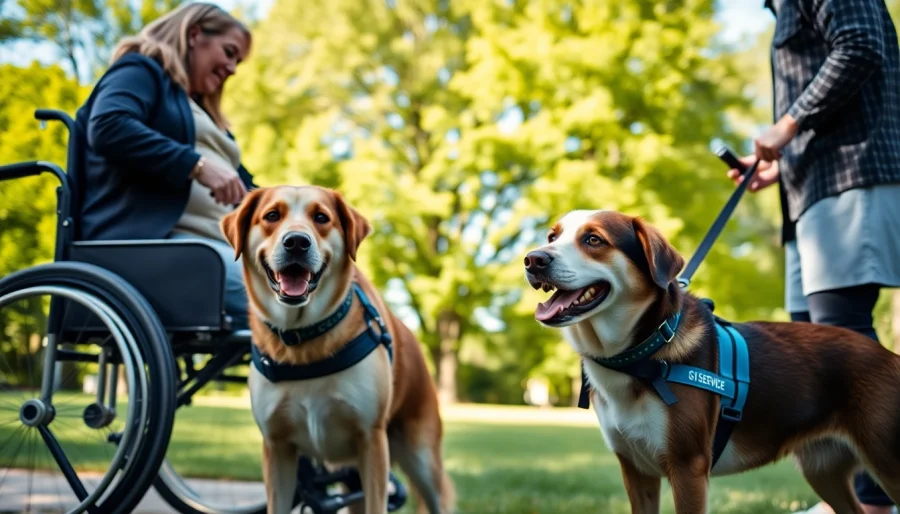What Are Service Dogs?
Definition and Purpose
Service dogs are specifically trained animals that provide assistance to individuals with disabilities. These dogs are more than just pets; they are companions that enhance the quality of life for people by performing tasks that are directly related to their owner’s physical and mental needs. They can assist individuals with mobility issues, medical conditions, or psychological disorders, thereby fostering independence and improving overall well-being. For those in need, service dogs are invaluable partners in navigating daily life.
Legal Rights and Access
The legal framework surrounding service dogs is primarily defined by the Americans with Disabilities Act (ADA). According to federal law, service dogs are permitted to accompany their handlers in all public places, ensuring that individuals with disabilities can access necessary services without barriers. This includes schools, hospitals, restaurants, and public transportation. However, it’s important for both service dog handlers and establishments to be informed about the rights and responsibilities under the ADA to prevent any misunderstanding or conflicts.
Different Roles of Service Dogs
Service dogs play various roles depending on the needs of their handlers. These roles can include:
- Mobility assistance, helping individuals with physical disabilities maneuver through different environments.
- Medical alert, notifying their owners of impending medical emergencies like seizures or low blood sugar.
- Psycho-social support, aiding individuals with conditions such as PTSD, anxiety, or depression.
The versatility of service dogs makes them indispensable for many individuals, allowing them to reclaim their autonomy and lead fuller lives.
Types of Service Dogs
Physical Assistance Service Dogs
Physical assistance service dogs are trained to aid individuals with mobility impairments. They can perform tasks such as retrieving objects, opening doors, turning on lights, and providing physical support while walking. These dogs are equipped to handle various physical tasks that make daily living easier for their handlers.
Medical Alert Service Dogs
Medical alert service dogs are trained to recognize specific medical conditions and alert their owners to potential emergencies. For example, a medical alert service dog can sense when a person is about to have a seizure and provide alerts or other assistance. They can also recognize and alert their handlers to dangerously low or high blood sugar levels, ensuring timely intervention and potentially saving lives.
Psycho-Social Support Service Dogs
Psycho-social support service dogs are focused on aiding individuals with mental health conditions such as anxiety, PTSD, and severe depression. These dogs can provide comfort, alleviate anxiety during stressful situations, and remind their handlers to take medication. They often serve as a bridge to social interactions, helping individuals feel more at ease in various settings.
How Service Dogs are Trained
Basic Training Techniques
The training of service dogs begins with foundational obedience skills, including commands like sit, stay, come, and heel. This training is essential for the safety and reliability of the service dog while in public. Additionally, socialization is a critical component, allowing dogs to become accustomed to various environments, sounds, and different types of people.
Specialized Task Training
Once basic obedience is established, service dogs undergo specialized training related to the needs of their potential handlers. This may include learning specific skills, like retrieving medication for a person with diabetes or guiding a visually impaired individual. This phase of training ensures that the dog can effectively support their handler in daily tasks.
Certification and Registration Process
While there is no legal requirement for service dogs to be certified or registered, obtaining a certification can be beneficial. It provides proof of training and readiness to assist individuals with disabilities. Various organizations offer certification programs that include evaluations to ensure the dog is capable of performing the necessary tasks. Handlers should be aware that documentation may facilitate smoother access to public spaces.
Benefits of Having a Service Dog
Improved Independence and Quality of Life
One of the most profound benefits of having a service dog is the sense of independence it brings to the handler. Service dogs enable individuals to perform tasks that they may struggle with due to their disabilities, fostering a greater sense of self-sufficiency. This independence translates into improved quality of life, allowing individuals to engage more fully in personal as well as social activities.
Emotional and Psychological Support
Beyond physical assistance, service dogs provide significant emotional and psychological support. They can offer comfort, reduce feelings of loneliness, and enhance emotional stability for their handlers. The bond between a service dog and its owner plays a crucial role in combating anxiety and depression, promoting mental wellness.
Social Interaction and Community Engagement
Service dogs can also facilitate social interaction for their handlers. Dogs often serve as conversation starters and create opportunities for social engagement that may otherwise be difficult for individuals with disabilities. Having a service dog can encourage community involvement, fostering connections and friendships.
Getting a Service Dog
Application and Adoption Process
The process of acquiring a service dog typically begins with an application to an organization that trains and places service dogs. This application often includes an assessment of the applicant’s needs and a discussion about the type of dog that would be most suitable. Following approval, the waiting period can vary, as it depends on the availability of trained dogs that match the applicant’s specific needs.
Choosing the Right Service Dog
Selecting the right service dog is crucial for ensuring compatibility and effectiveness. Factors to consider include the dog’s temperament, size, and energy level. A successful match will align with the handler’s lifestyle, needs, and personality. Engaging with trainers and attending meet-and-greet opportunities can assist in making an informed decision.
Maintaining the Bond with Your Service Dog
Once paired with a service dog, maintaining the bond is vital for both the handler and the dog. Regular training sessions and positive reinforcement techniques help strengthen the relationship and ensure that the dog continues to perform its tasks effectively. Additionally, providing proper care, including exercise, grooming, and healthcare, enhances the dog’s overall well-being, thereby improving the service provided to its handler.
